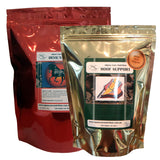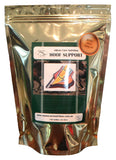Insulin Resistance and Equine Metabolic Syndrome
 I've got one in my paddock, 'Mighty' the miniature pony, and some of you will have too. The horse or pony that "runs on the smell of an oily rag", and whilst it's tempting to turn a bit of a blind eye on our 'easy keepers', be very much aware that what might be going on is a metabolic disorder that needs active management for the well being of the animal.
I've got one in my paddock, 'Mighty' the miniature pony, and some of you will have too. The horse or pony that "runs on the smell of an oily rag", and whilst it's tempting to turn a bit of a blind eye on our 'easy keepers', be very much aware that what might be going on is a metabolic disorder that needs active management for the well being of the animal.
Obesity and Type II diabetes is a hot topic for us humans and Equine Metabolic Syndrome (EMS) is the 'disorder du jour' for our horses. EMS is both a metabolic and a hormonal disorder. Affected animals are metabolically very efficient, with a strong genetic predisposition. Any breed can develop EMS, but it is more commonly seen in breeds that evolved in harsh climates such as many pony breeds (Shetland, Mountain, Welsh etc) and breeds such as Morgans, Spanish Mustangs, Peruvian Pasos and Paso Finos. Susceptible animals are at risk as soon as they reach maturity.
The hormonal elements of the disorder are abnormal levels of insulin and insulin resistance. All tissues in the body need glucose for energy and most tissues need a certain type of protein to help get the glucose out of the bloodstream and into the tissue. Some of these proteins are 'switched on' by insulin and when they begin to fail the body makes more insulin to try and compensate. The result is insulin resistance: insulin is not effective or as effective as it should be and glucose is not being taken up by the target cells. Higher than normal blood insulin levels are characteristic of EMS and they can be a trigger factor for laminitis. Indeed chronic, recurrent laminitis is often the first symptom that is picked up on. Other symptoms include: obesity, a cresty neck, and regional fat pads for instance at the tail, head and eye pockets. A vet will be able to diagnose EMS with blood tests.
EMS cannot be cured, but it can be managed through a three-pronged approach: weight loss, dietary management and exercise. A suitable diet should consist of low sugar/starch grass hay, with plain beet pulp to carry minerals (balanced to make up for inadequacies in hay), vitamin E and essential fatty acids. Animals should not be starved, as this can make insulin resistance even worse, as the body goes into 'starvation mode'. Particular care should be taken with ponies, minis and donkeys. They can mobilize large amounts of fat when fasted or stressed resulting in hyperlipidemia. This massive mobilisation of fat can lead to liver and kidney failure, with fatality in the 40-70% range after onset.
Exercise not only promotes weight loss, but can increase insulin sensitivity by stimulating the uptake of glucose by muscle tissue, reducing insulin resistance. A study carried out in 2006-2008 concluded that "Turnout may not be sufficient to improve insulin sensitivity, but an exercise regimen comparable with light or moderate intensity exercise...may be recommended as a management strategy to improve insulin sensitivity" . Whilst a 2006 study found that moderate exercise for 7 consecutive days not only increased insulin sensitivity, but that these enhancements in sensitivity were still evident after 5 days of inactivity . Whilst these two studies used healthy non-EMS horses, a 2002 study looked at the effects of short-term exercise training on insulin sensitivity in both lean and obese mares, using untrained aged mares. The obese mares in the study were confirmed insulin resistant. With moderate exercise however increases in insulin sensitivity occurred even in the obese, insulin resistant group .
With exercise being so important, work out ways to increase movement, bearing in mind fitness levels and any foot pain from laminitis. Set up a 'Paddock Paradise' track (Mighty the mini wobbles round our track chasing a 17 hand hothead Thoroughbred, a Warmblood showjumper and an Arab x filly), walk in hand, lead off a riding horse, lunge or get kitted up with boots and pads and go for some regular gentle trail rides. Your horse or pony will benefit, and you never know, it might help keep us humans a bit trimmer too!
|
RELATED PRODUCTS |
|||
 |
 |
 |
 |
| Omega-3 | Laminitis Recovery |
Devil's Claw |
Hoof Support |